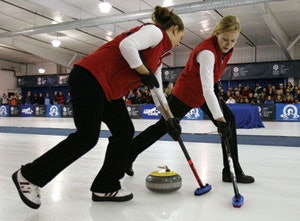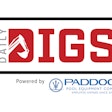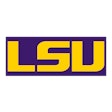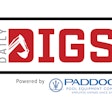As strange as it sounds, curling has the potential to fill up rinks during off-peak hours.

But that might be changing. Fourteen new curling clubs have just come online, bringing the total to 154 - of which around 90 utilize dedicated curling rinks. The other 64 or so rent ice time at private and public rinks, working around the schedules of more established hockey and figure skating programs.
The situation in Burnsville, Minn., is typical. "We give ice time to our long-time partners first, and the Dakota Curling Club came to us for the first time last spring," says Dean Mulso, the city of Burnsville's recreation facilities manager. "Just to get their foot in the door they took ice time in April, May and early June. They wanted November to April, Monday to Friday like everybody else, but I can't bump my current users out. They have to work within the parameters of the available ice."
The Potomac Curling Club in Washington, D.C., was founded in 1961 and rented ice in three different facilities before constructing the four-sheet National Capital Curling Center, which opened in February 2002. Dominique Banville, the club's president, says the nomadic life had its limitations.
"The club played only one night a week, Monday, with time for two draws, at 7:30 and 9:30," she says. "The problem was that the stones were stored off the ice, so they'd be warmer than the ice itself. The players would put them on the ice 15 minutes before the start of the first draw, but the first stones could barely make it across the ice, and wherever they stopped they'd melt the ice and produce a circle. Those were not great conditions."
Curling in many ways would seem to be a natural programming addition for many rink owners. Necessary equipment begins and ends with a set of sixteen 42-pound granite stones, a high cost (about $8,000 per set) that is borne by the clubs themselves. Ice maintenance is a simple matter of performing a dry shave and then pebbling the ice with a backpack-mounted sprayer. (The bumpiness created by the light mist of water allows the stones to glide more easily by reducing ice surface friction.) In addition, Banville says, attracting newcomers to the sport isn't difficult since it appears to be within the capabilities of the average viewer.
"It looks like anybody can do it," she says, "at least when compared to figure skating and snowboarding."
There are challenges, however, beginning with the downside of curling's burgeoning popularity. The sport made the newspapers this fall when it appeared that, as a result of Scottish manufacturers not being able to keep up with demand, between 20 and 30 American clubs might not get their sets of stones in time for the new season. While several leagues were forced to delay the openings of their seasons, a shipment arrived in late November for distribution by USA Curling, which leases stones to new clubs at reduced rates, with purchase or return of the sets expected at the end of two years.
Another difficulty is rink owners' general lack of familiarity with curling's facility requirements, according to USA Curling's chief operating officer, Rick Patzke.
"There are some different nuances to it," he says. "Many rinks get a dish effect after awhile, where the ice is thicker around the edges and scooped out in the middle. So it's a little tough to have great curling ice if you just have a two- or three-hour rental time. We send out manuals, have instructors who can share tips and host a sort of 'Arena 101' program for making curling ice."
Since the sport's greatest growth currently is in hockey rinks (most of this country's curling centers are between 20 and 40 years old), facility managers have had to learn to be creative with ice markings. Patzke isn't too particular - "Anything as simple as taking a wide magic marker and outlining the circles, and then scraping it right off afterward," he says - but more facilities are putting down circles within their hockey markings, much as basketball and volleyball lines overlap on some indoor courts. Burnsville is one such rink, having installed circles for curling last March.
"The first week, the figure skating club got confused because the skaters tend to take off on their jumps from the face-off circles," Mulso says. "But the hockey coaches are using the markings to their benefit during skating drills rather than as a distraction. They love it."
The Dakota Curling Club's 2007 season will run all the way into July, and Mulso is toying with the possibility of helping the club run a late-summer league when that one's done. "Normally, they organize all their leagues, but they may not want to run a summer league themselves because it's so off-peak it might fall flat on its face," Mulso says. "I'd almost rather do it myself because it could be more profitable that way - as long as I don't have to make the investment in the stones."
Most curling clubs have always had to run their programs themselves, but the few that have undertaken the construction of their own facility have found that some help is available. The Potomac Curling Club was the beneficiary of free land and a matching grant from the state of Maryland, as well as an interest-free loan from the World Curling Federation. Membership fees as well as tax-free donations (the club is organized as a 501(c)3 nonprofit corporation) combine to pay off the 10-year loan and operate the facility.
With curling sheets just 15 feet, 7 inches wide and 146 feet long, three parallel surfaces require a much smaller building envelope (although the ice must be colder) than a hockey rink. Still, 200 members can only do so much to pay the taxes and keep the chillers running, so the roughly $1 million Potomac facility was built lean. The ice sheet rests on a sand base rather than concrete, for example, and the building features few frills (locker rooms are superfluous to curlers who can compete in street clothes, and there's no need for an ice resurfacer). The newest curling-specific facility to open, the three-sheet Nutmeg Curling Club in North Bridgeport, Conn., is similarly spare but valued more for its playing surface than its ambiance.
The best way to keep things cool, of course, is to attract new members, which hasn't been as much of a problem since the 2002 Winter Games. "We opened the year Americans realized curling existed, and we got a big boost in our membership," says Banville. "We were bombarded by media requests to cover the sport prior to the 2002 Olympics, and then afterward we had hundreds of people stopping by the club. After the 2006 Olympics, we had thousands."
The Potomac club has made some headway in attracting junior players to a Sunday afternoon league, and this season's target is a nearby retirement community. "The club is fully utilized at night, but during the day it is totally empty, so our objective now is to develop the daytime," Banville says. "In the prairies in Canada and the Midwest, a lot of the regular players are retirees or farmers, who obviously have seasonal jobs. Clubs there are as busy in the daytime as the nighttime."
Curling's potential growth elsewhere positively warms the hearts of rink operators like Mulso. "At this point, we haven't had to invest time or money in it," he says. "It's revenue we didn't have in the past, and it doesn't require as much maintenance as hockey or figure skating. It's a nice supplement for us."
































